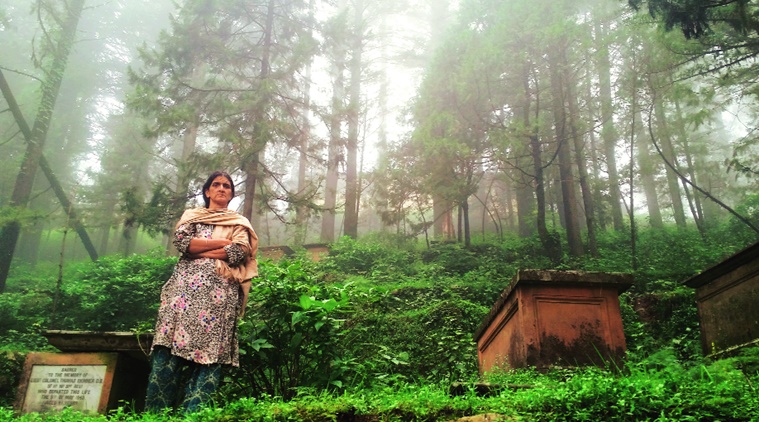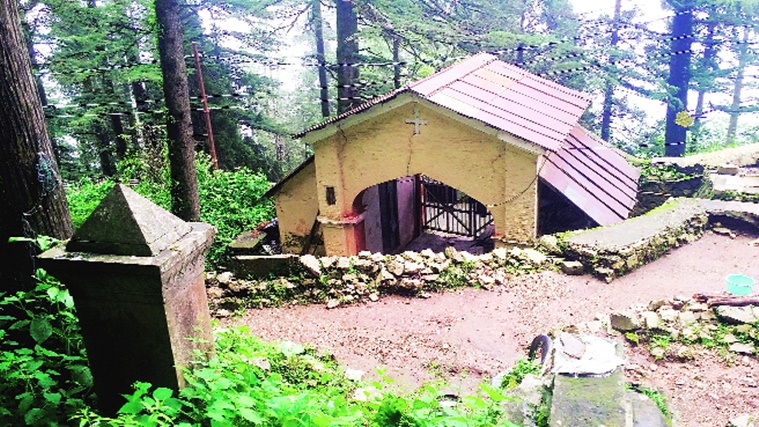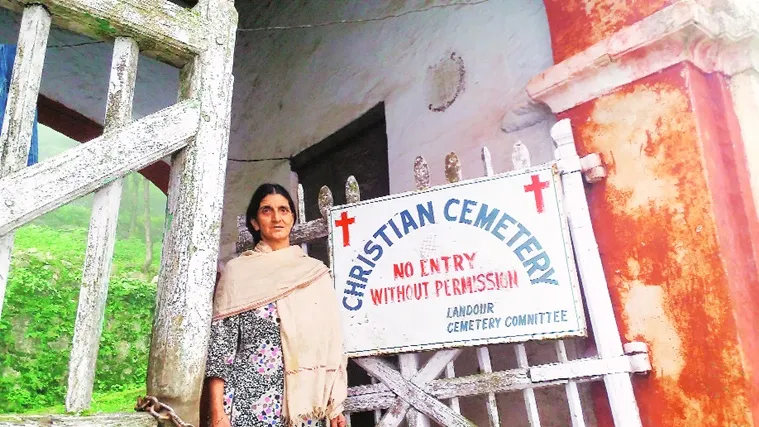- India
- International
One Foot in the Grave
How a poor Hindu family came to make the Christian Cemetery in Landour their home for nearly 40 years.
 In her care: Shanta Semwal. (Photos: Rahul Nair)
In her care: Shanta Semwal. (Photos: Rahul Nair)
Nothing is out of the ordinary. The clouds, holding the rain, are hazing over. The paths, lined by deodar and pine trees, are wide and empty. I am walking on a circuitous road expecting to see more cottages when I come across an imposing gate and a board that reads: Christian Cemetery Landour. It was established in 1828 but locals say there were graves at this spot in the early 1820s. So far, Landour, a cantonment town, contiguous with Mussoorie, Uttarakhand, has appeared like a holiday destination for the rich: an aloof place of five-star hotels and expensive cafés. But with each step in my long, meandering walk, the town has begun to charm me — when finally, the cemetery becomes visible and all existing notions dissolve.
The 1.5-acre cemetery spreads over both sides of the road. The right side is secured with a gate and has none of the eerie disquiet of the left — excited Garhwali chatter can be heard from a thatched-roof hut at its edge. It’s an oddity amid the uppity airs of the hill town draws me in.
 In her care: Inside the Christian Cemetery Landour. (Photos: Rahul Nair)
In her care: Inside the Christian Cemetery Landour. (Photos: Rahul Nair)
Soon, an elderly gentleman reaches the gate. He uses his walking stick to tap it and screams, “Panditji.” “Panditji.” A Panditji in a Christian cemetery in a cantonment area? My interest piques.
But Panditji, we learn, died a few weeks ago. His wife, 50-year-old Shanta Semwal, is now the caretaker. She asks me to come inside as the old man and another visitor leave, and locks the gate. I see numerous tombstones ascending on the mountain.
In the mid-1980s, 16-year-old Shanta married Manor Semwal (Panditji), who had moved to Landour only a few years ago from a life of farming in Kot village in Pauri Garhwal, looking for a job. The gates of Christian Cemetery were thrown open for a caretaker and Shanta made the cemetery her marital home. Thus began the process of following the pastor with the corpse to aid with the burial. The job of the caretaker of the oldest cemetery in all of Mussoorie entailed an education in the history of Landour.

“We are Brahmins,” Semwal says, “My husband could have been a Pandit in a temple, but we are kabristaanwale (graveyard keepers). It’s our destiny.”
“Who rests here?” I ask. Semwal responds with the air of someone repeating something often heard, “The British. The oldest graves are of those who died in the malaria outbreak of 1848. There are also 13 World War I soldiers.”
“Anyone well-known?”
“(Author) Ruskin Bond,” she says, “but he is alive and comes here often,” and laughs uproariously. It’s a joke I would laugh at later. Right now, I am stunned, and only manage to smile. She takes me around the cemetery, pointing at the graves of the World War I soldiers of the West Yorkshire Regiment whose tombstones were recently restored by The Commonwealth War Graves Commission, the UK. “There’s (engineer Proby) Cautley,” she tells me. She can’t read, but remembers where the grave is, “who built the canal on Ganga,” and somewhere, she can’t remember exactly where, is lieutenant-colonel Thomas Skinner of the Skinner regiment of the British Indian army. As we return to the hut, having read touching epitaphs on the way, she points to a tree. “Hundred-and-fifty-year-old cypress tree”, she says. “Planted by the Duke of Edinburgh in 1871.”
 In her care: Shanta Semwal at the Christian Cemetery Landour. (Photos: Rahul Nair)
In her care: Shanta Semwal at the Christian Cemetery Landour. (Photos: Rahul Nair)
It’s that tree which eased the fears of a 16-year-old Semwal when she first arrived in Landour. It was really the fear of seclusion, of the unknown, and not the thought of ghosts, that scared her. “Unaware of what graves were”, the trees made her believe the cemetery was actually “a garden”. “That’s what I told my children as well: Yes, there are graves here but there are trees too.” Even while talking to me, her eyes search for the cypresses and deodars.
She releases a few goats, calves and a cow to graze around in the cemetery and continues with our conversation. They lived in a small hut with no electricity and a tap outside the hut for water. “We got electricity here in 2006. Till then, my children would fight over a candle to study.” If the children expressed any disappointment at where they live, she would tell them: “We’re lucky. Not many have the opportunity to live on a land as vast and green.”
But the living costs were high. Buying vegetables was expensive. They tried to farm, grow vegetables somewhere in the cemetery but between the humans and trees, in the quest for colonising the land, the trees won. No trees could be felled in Landour. That’s when the Semwal couple turned labourers. They would rent mules to carry sand, stones and bricks to construction sites and earn daily wages which helped educate their children. But of their four children, only two, 25-year-old Ankit and 26-year-old Monica, completed graduation. The other two dropped out of school.
As the children grew up, the cemetery became a dharohar (monument). Land for the last grave was bought in the early 2000s and filled three years ago. “The Christians here don’t die,” Semwal says in a lighter vein (many Landour Christians like the late actor Tom Alter preferred to be cremated. He was cremated in Mumbai). “Why would they? They are safe at home. They are not worn out. It’s the poor who dies.”
The Semwal children are now grown up, and assisted by their financial independence, the family has bought their own house close-by, but, Semwal rues, there is no place for the cattle in the new house. Her cows and goats continue to live in the cemetery, and by extension, so does she: It’s the cemetery she returns to, every morning and evening.
“This is my home,” she says. “When my husband died, there was a mela (fair) here for days afterwards.” “Lambi chaudi jawani kabristaan mein bita di (I spent the glorious days of my youth in the cemetery),” she sighs. “Par ab budhapa hai, jiski umar aur bhi lambi hoti hai (But now old age has dawned, which is so much longer).”
May 07: Latest News
- 01
- 02
- 03
- 04
- 05





































